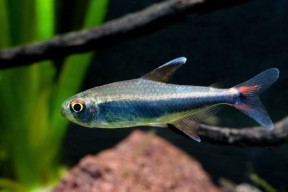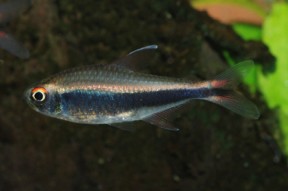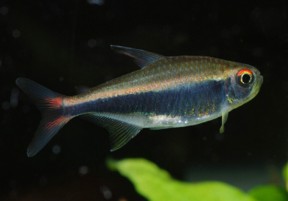Hyphessobrycon peruvianus
Peruvian Tetra
Etymology
Hyphessobrycon: from the Ancient Greek υπελάσσων (hyphesson), meaning ‘of lesser stature’, and used as a prefix in this case, plus the generic name Brycon.
peruvianus: ‘from Peru’.
Classification
Characidae
Distribution
Known only from the upper Amazon basin in Peru including the ríos Amazonas-Solimões, Marañón, Napo, Itaya, Tigre, Corrientes, and Ucayali.
Type locality is ‘Between Tabatinga and Iquitos, Upper Amazon, Loreto State, Peru’.
Habitat
Little information is available, but the majority of collections appear to have been from small, shallow tributary streams often referred to as quebradas in Peru.
Such habitats are characterised by large amounts of overhanging riparian vegetation, submerged branches, tree roots and leaf litter, and the water is typically stained the colour of weak tea due to substances released by decomposing organic matter.
Maximum Standard Length
30 – 40 mm.
Aquarium SizeTop ↑
An aquarium with base dimensions of 60 ∗ 30 cm or equivalent should be the smallest considered.
Maintenance
Perhaps looks best in an arrangement comprising a sandy substrate plus some driftwood roots and branches, or heavily-planted planted set-up.
The addition of dried leaf litter would further emphasise the natural feel and as well as offering additional cover for the fish brings with it the growth of microbe colonies as decomposition occurs.
The latter are useful since they provide an additional food source for both adults and fry while the humic substances released by decaying leaves are also considered beneficial.
This species seems to do best under relatively dim lighting and plant species from genera such as Microsorum, Taxiphyllum, Cryptocoryne or Anubias are recommended since they will grow under such conditions, and a few patches of floating vegetation may also prove effective.
It is relatively intolerant to accumulation of organic pollutants and requires spotless water meaning weekly water changes should be considered routine, and it should never be introduced to a biologically immature tank.
Water Conditions
Temperature: 22 – 27 °C
pH: 5.0 – 7.0
Hardness: 36 – 179 ppm
Diet
Probably an opportunistic omnivore by nature feeding on aquatic invertebrates, fallen fruit and suchlike.
In the aquarium it is easily-fed but the best condition and colours offer regular meals of small live and frozen foods such as bloodworm, Daphnia, and Artemia alongside good quality dried flakes and granules, at least some of which should include additional plant or algal content.
Behaviour and CompatibilityTop ↑
Generally peaceful making it an ideal resident of the well-researched community aquarium.
It is perhaps best-maintained alongside similarly-sized characids, gasteropelecids, lebiasinids, smaller callichthyid or loricariid catfishes and non-predatory, medium-sized cichlids.
Try to buy a mixed-sex group of at least 8-10 specimens, include other schooling fishes to provide security, and you’ll be rewarded with a more natural-looking spectacle.
Sexual Dimorphism
Adult males are slightly more intensely-coloured when in good condition while females tend to grow a little larger and be rounder in shape, especially when gravid.
Reproduction
Egg-scatterer exhibiting no parental care.
NotesTop ↑
This species is popular in the ornamental trade, although it is sometimes confused with the similar-looking congeners H. loretoensis and H. metae. In particular, it has repeatedly appeared under the name H. metae in aquarium literature.
It can be identified via the following combination of characters as per Géry (1977): elongate in shape with body depth fitting 3.8-3.9 times in its standard length; caudal peduncle narrow, its depth fitting 1.8 times in its length; head short, interorbital broad, snout short and rounded; dorsal-fin insertion anterior to midbody; 9-10 predorsal scales; (8-10) 34-35 lateral scales; caudal-fin red or brownish.
H. loretoensis and H. metae are both less elongate with body depth fitting less than 3.6 times in its standard length and the caudal peduncle depth fitting 1.2-1.75 times in its length, plus their snouts are of moderate length and pointed in shape. H. loretoensis further differs from H. peruvianus in possessing 10-11 predorsal scales, (5-7) 33-34 lateral scales and a bright brick-red caudal-fin, while the dorsal-fin insertion is located at or ‘scarcely’ anterior to midbody. H. metae has 9-10 predorsal scales, (6-9) 30-31 lateral scales and the dorsal-fin insertion is posterior to midbody.
The three species also exhibit differences in colour pattern; in both H. loretoensis and H. peruvianus there is a broad dark band in the lower portion of the body, between the opercle and caudal peduncle, whereas in H. metae the dark band is prominent only on the caudal peduncle itself. In addition, the dark band extends to the tips of the median caudal-fin rays and there is a bright red marking at the base of both caudal-fin lobes in H. peruvianus, but in H. loretoensis the dark band extends only slightly onto the caudal-fin, which is a more-or-less solid brick red colour. In H. metae the dark caudal peduncle marking continues onto the base of the median caudal-fin rays, and there is a yellow-to-orange marking at the base of each caudal-fin lobe.
All three species are included in the putative H. aghula group of closely-related species within the genus as proposed by Géry (1977, see below) of which members share the following characters which set them apart from other characids: lower half of the body dark, especially above the anal-fin; usually possessing a laterally-elongate humeral spot, more-or-less united with a broad asymmetrical lateral stripe. Other species in this group include H. agulha and H. herbertaxelrodi, although some authors have included one or more of these, including H. peruvianus, in the H. heterohabdus group.
Lima et al. 2014 noted similarities between the H. aghula group and their revised H. heterorhabdus group which comprises Hyphessobrycon heterorhabdus, H. amapaensis, and H. eschwartzae. This trio all possess: a well-defined, elongate humeral blotch which is continuous with a dark, well-defined midlateral stripe that becomes blurred towards the caudal peduncle; a longitudinal red stripe extending along the body above the midlateral line; upper half of the eye red.
This pattern is different to that presented by several members of Géry’s original H. heterorhabdus group, such as H. vilmae, H. cachimbensis, and H. stegemanni, which possess a continuous, solid dark lateral stripe on the body and no obvious humeral blotch.
Hyphessobrycon was raised by Durbin in Eigenmann (1908) as a subgenus of Hemigrammus, differing from the latter by the absence of scales on the caudal-fin.
The grouping was revised by Eigenmann (1918, 1921) while Géry (1977) created artificial groups of species based on colour pattern, and these definitions are still widely used today, e.g., the H. agulha group, the H. heterohabdus group, etc. These cannot be considered to represent monophyletic assemblages, however, and their concepts continue to be redefined.
Weitzman & Palmer (1997) hypothesised the existence of a monophyletic assemblage within the genus based on colour pattern and male fin morphology that they termed the ‘rosy tetra clade’, with one of the characters supporting its monophyly being presence of a prominent dark marking on the dorsal-fin. This assemblage, plus other morphologically similar species, is considered to represent Hyphessobrycon sensu stricto by some authors, with the remaining species included in a much-expanded H. heterohabdus group.
Others have proposed conflicting, typically more restricted, views of both the genus and/or its constituent species groups, and significant confusion remains. What is clear is that, as currently recognised, Hyphessobrycon is a polyphyletic lineage containing several genera.
The process of splitting it up has already started, and Malabarba et al. (2012) revalidated the genus Ectrepopterus Fowler, previously considered a synonym of Hyphessobrycon. They also analysed its relationships within the Characidae in the context of Mirande’s (2010) previous work, but included the type species, H. compressus, for the first time in such a study. The results demonstrated that H. compressus is more closely-related to ‘rosy tetra’ representatives such as H. eques, H. pulchripinnis, and H. socolofi than other members of the genus including H. anisitsi, H. bifasciatus, H. elachys, H. herbertaxelrodi, and H. luetkeni.
References
- Ladiges, W., 1938 - Wochenschrift für Aquarien- und Terrarienkunde 35(41): 645-646
Ergebnisse einer Sammelexpedition nach dem mittleren Amazonenstrom (Fortsetzung). - Calcagnotto, D., S. A. Schaefer, and R. DeSalle, 2005 - Molecular Phylogenetics and Evolution 36(1): 135-153
Relationships among characiform fishes inferred from analysis of nuclear and mitochondrial gene sequences. - Géry, J., 1977 - T.F.H. Publications, Inc.: 1-672
Characoids of the World. - Lima, F. C. T., D. P. Coutinho and W. B. Wosiacki, 2014 - Zootaxa 3872(2): 167-179
A new Hyphessobrycon (Ostariophysi: Characiformes: Characidae) from the middle Amazon basin, Brazil. - Malabarba, L. R., V. A. Bertaco, F. R. Carvalho & T. O. Litz., 2012 - Zootaxa 3204: 47-60
Revalidation of the genus Ectrepopterus Fowler (Teleostei: Characiformes), with the redescription of its type species, E. uruguayensis. - Mirande, J. M., 2010 - Neotropical Ichthyology 8(3): 385-568
Phylogeny of the family Characidae (Teleostei: Characiformes): from characters to taxonomy. - Oliveira, C. A., G. S. Avellino, K. T. Abe, T. C. Mariguela, R. C. Benine, G. Orti, R. P. Vari, and R. M. Corrêa e Castro, 2011 - BMC Evolutionary Biology 11(1): 275-300
Phylogenetic relationships within the speciose family Characidae (Teleostei: Ostariophysi: Characiformes) based on multilocus analysis and extensive ingroup sampling. - Ortega, H. and R. P. Vari, 1986 - Smithsonian Contributions to Zoology No. 437: iii + 25 p.
Annotated checklist of the freshwater fishes of Peru. - Reis, R. E., S. O. Kullander and C. J. Ferraris, Jr. (eds), 2003 - EDIPUCRS, Porto Alegre: i-xi + 1-729
Check list of the freshwater fishes of South and Central America. CLOFFSCA. - Weitzman, S. H. and L. Palmer, 1997 - Ichthyological Exploration of Freshwaters 7(3): 209-242
A new species of Hyphessobrycon (Teleostei: Characidae) from the Neblina region of Venezuela and Brazil, with comments on the putative `rosy tetra clade'. - Zarske, A., 2014 - Vertebrate Zoology 64(2): 139-167
Zur Systematik einiger Blutsalmler oder "Rosy Tetras" (Teleostei: Ostariophysi: Characidae).





